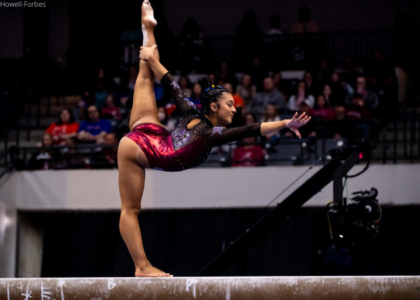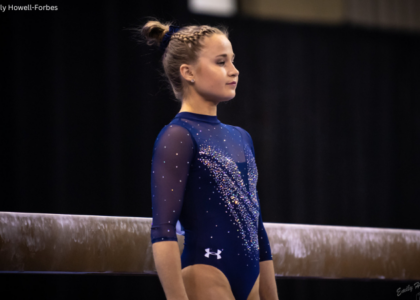Division III scores on average tend to be lower than most Division I teams, as Division I teams have an advantage in recruiting and resources compared to their Division III counterparts. This doesn’t mean there aren’t Division III gymnasts doing Division I-caliber gymnastics, but are they being judged harder just because of their division?
I asked our CGN DIII experts to find some good routines with high start values that are similar to what is seen completed at the DI level. Then, I searched for DI routines with similar scores and composition to try to get a fair and accurate comparison. Whichever routine is judged “harder” (or more accurately in some cases), gets a point for the division. I’ll tally the points after each event and at the end to determine which division is scored more harshly.
Vault
Yurchenko Layout Half (9.95 Start Value)
Division III: Natalie Steed, Ithaca March 3, 2024
Deductions: body position on landing (-0.05), underrotation (-0.05), large step back (-0.2), shoulder angle (-0.05)
Score: 9.725
My Score: 9.600
Division I: Hannah Weklar, Temple, Jan 23, 2024
Deductions: leg form (-0.05), large step forward (-0.2), arm bend (-0.05)
Score: 9.750
My Score: 9.650
Analysis: Although I would have been lower on both of these vaults—and Steed’s landing made me worry about her knees—there’s no deduction for landing with straight legs, so these vaults seem to be scored about the same. Remember the direction lines are only used for the initial landing, not the step, so Weklar would likely not receive a direction error for this vault.
Yurchenko Tuck Full (9.9 Start Value)
Division III: Kendall Huff, Centenary, February 26, 2024
Deductions: leg separation on table (-0.05) and in air (-0.05), foot form on table (-0.05) and in air (-0.05), chest position on landing (-0.05), small step (-0.05)
Score: 9.600
My Score: 9.600
Division I: Gabriella Hartley, Air Force, March 9, 2024
Deductions: shoulder angle (-0.05) arm bend (-0.05) leg separation (-0.05) knee bend (-0.05) on table; leg separation (-0.05), foot form (-0.05) in air; chest position on landing (-0.1), hop on landing (-0.1)
Score: 9.550
My Score: 9.400
Analysis: I got lucky and found two very similarly scored vaults, but the big difference is Hartley bends her legs early and lands with her chest much lower than Huff. Huff’s vault was judged accurately while Hartley’s is definitely overscored.
Yurchenko Full (9.95 Start Value)
Division III: Lily Horsch, Gustavus Adolphus, March 2, 2024
Deductions: arm bend (-0.05) leg form (-0.05) body position (-0.05) two steps on landing (-0.2)
Score: 9.500
My Score: 9.600
Division I: Sofia Huang, William & Mary, February 16 2024
Deductions: leg separation in air (-0.05), foot form (-0.05), body position pike (-0.05), step back (-0.1), balance error (-0.05), small foot adjustment (-0.05)
Score: 9.650
My Score: 9.600
Analysis: I thought these vaults were pretty comparable, with both clean with a small pike down in the air and some landing deductions. Although the Horsch video quality is not as good, I do think that vault was judged harder than Sofia Huang’s vault.
Total After Vault
Division III: 2
Division I: 0
Tie: 1
Bars
Division III: Emily Buffington, UW-Oshkosh, March 9, 2024
Routine: blind change, straddle Jaeger to shoot over, Arabian double front dismount (10.0 SV)
Deductions
Arm bend on release catch (-0.1)
Leg separation (-0.05)
Staggered feet on landing (-0.05)
Score: 9.900
My Score: 9.80 0
Division I: Carly Bauman, Michigan, March 1, 2024
Routine: toe circle to handstand to blind change, straddle Jaeger to shoot over, blind change double front dismount (10.0 SV)
Deductions:
Two small steps on landing (-0.1)
Score: 9.900
My Score: 9.900
Analysis: Not to take anything away from Buffington’s fantastic bar routine, but Bauman had better rhythm, amplitude, and form in her releases, which is what made the difference in these nearly identical bar routines. Buffington was overscored in this match up.
Division III: Emma Grace Sargent, Brockport
Routine: giant half, straddle Jaeger, shoot over to handstand, double layout (10.0 SV)
Deductions:
Leg separation/head alignment (-0.05)
Foot form (-0.05)
Too close on catch (-0.05)
Body position/leg form (-0.05)
Cast HS body position (-0.05)
Small step on landing (-0.05)
Score: 9.850
My Score: 9.700
Division I: Sarah Haxton, Kent State, March 3, 2024
Routine: giant half, straddle Jaeger to shoot over, double layout (10.0 SV)
Deductions:
Bent arms on catch (-0.05)
Amplitude on bail (0.05)
Body position on landing (-0.1)
Score: 9.925
My Score: 9.800
Analysis: Haxton and Sargent have very similar routines. I did have Haxton’s routine slightly higher than Sargent’s, as she had fewer small form breaks, although I would argue that Sargent’s skills had better amplitude overall. In this case, Sargent was more overscored than Haxton, especially since there were a couple places I took “quarter tenths” for small deductions, which is common in NCAA but not actually part of the rules.
Division III: Sarah Best, UW-La Crosse, March 9, 2024 (Start at 43:40)
Routine: Maloney to bail to handstand to toe shoot, double layout (10.0 SV)
Deductions:
Leg bend (-0.05)
Knee bend on tap (-0.05)
Body position (-0.05)
Step backwards (-0.05)
Score: 9.800
My Score: 9.800
Division I: Rosie Casali, Denver, January 26, 2024
Routine: toe hand to Maloney to bail to handstand, double layout (10.0 SV)
Deductions:
Arm swings (0.05)
Balance error (-0.05)
Hop forward (-0.1)
Failure to hold finish position: (-0.05)
Score: 9.750
My Score: 9.750
Analysis: I agree 100% with both of these scores. Good job, judges!
Total After Bars
Division III: 2
Division I: 2
Tie: 2
With what I’ve seen so far, vault tends to get more overscored in DI, but bars is more likely to be overscored in DIII.
Beam
Division III: Julia Reer, Springfield, January 22, 2024
Routine: back handspring layout step-out, kick over front tuck, switch split jump series, back handspring double full (10.0 SV)
Deductions:
Leg form (-0.1)
Leg form (-0.05)
Squat on landing (-0.1)
Amplitude of first leg separation (-0.05) on each jump = (-0.1)
Leg form (-0.1)
Hop back on landing (-0.1)
Score: 9.675
My Score: 9.450
Division I: Gabby Wilson, Michigan, January 27, 2024
Routine: back handspring layout step-out, switch split jump series, round-off double back (10.0 SV)
Deductions:
Balance error (-0.15)
Amplitude of first leg separation (-0.05) on each jump = (-0.1)
Step back on landing (-0.1)
Score: 9.775
My Score: 9.650
Analysis: I actually looked this up, and in a switch split jump, the first leg needs to lift at least 30 degrees. In my opinion, neither of these athletes hit that mark (for reference, Wilson’s legs in the screenshot of her dismount landing are about 30 degrees apart). While they both had obvious errors in their routines, my score was farther from the official score on Springfield’s Julia Reer than on Wilson’s routine. So, the DIII score was not “harsher” than DI in this case.
Division III: Effie Ferguson, UW-Stout, January 21, 2024
Routine: front toss to beat jump, back handspring layout step-out, switch leap straddle quarter, round-off back one and a half (10.0 SV)
Deductions:
Balance error (-0.1)
Rhythm (-0.05) (yes, this is actually broken, but it’s NCAA connected)
Leg form (-0.05)
Small step (-0.1)
Score: 9.700
My Score: 9.700
Division I: Emma Strom, Arizona, March 8, 2024
Routine: switch leap straddle quarter, back handspring layout, double wolf turn, roundoff back one and a half
Deductions:
Balance error (-0.1)
Hop on landing (-0.1)
Score: 9.800
My Score: 9.800
Analysis: Two strong beam routines with similar errors, and I agree with both scores.
Total After Beam
Division III: 2
Division I: 3
Tie: 3
Floor
Division III: Alexis Castellaneta, Utica, February 11, 2024
Routine: double pike, switch side straddle full, front full to front layout, double tuck
Deductions:
Precision of turn in jumps (-0.05)
Score: 9.900
My Score: 9.950
Division I: Sydney Leitch, Boise State, March 1, 2024
Routine: double pike, switch half wolf full, front layout to front full, double tuck
Deductions:
Foot adjustment (-0.05)
Precision of turn (-0.05)
Foot adjustment (-0.05)
Score: 9.875
My Score: 9.850
Analysis: I was honestly very impressed with Castellaneta’s floor routine. She has great control over her powerful tumbling and could make the lineup for one of the top DI floor teams. Leitch had a great set as well but didn’t quite have the precision on her landings that we saw from Castellaneta, who I think was underscored.
Division III: Olivia Keys, Rhode Island College, Feb 18, 2024 (start at 1:48:00)
Routine: front tuck through to double tuck, switch side half straddle, double pike
Deductions:
Foot adjustment (-0.05)
Leg bend (-0.05)
Foot adjustment (-0.05)
Score: 9.900
My Score: 9.850
Division I: Keira Thornton, Bowling Green, 22 January, 2024
Routine: front tuck through to double tuck, switch half straddle full straddle full, double pike
Deductions:
Chest position on landing (-0.05)
Foot adjustment (-0.05)
Landing control/adjustment (-0.1)
Score: 9.800
My Score: 9.800
Analysis: These were great routines from both athletes, but I thought the DIII routine was underscored compared to scoring standards for NCAA.
Final Total
Division III: 4 harder-judged routines
Division I: 3 harder-judged routines
Tie: 3
After looking at these 10 routines, there seemed to be a pretty equal mix of harshly judged routines for both Division III and Division I athletes. Bars and floor were the most accurate of the events, with vault definitely being more overscored in DI and floor being more underscored compared to DI. My analysis is limited, as I only looked at 10 routines out of the countless we’ve had this season, but since the same judges evaluate DI and DIII athletes, it makes sense that they would also see their fair share of crazy and accurate scores. I will say, though, that judges seem more comfortable throwing out low scores and less comfortable with high ones in DIII while the reverse is true in DI.
READ THIS NEXT: Judge’s Inquiry: Using the College Code to Judge Sooner Recruits From the Nastia Liukin Cup
Article by Rhiannon Franck
Rhiannon Franck is a former national-rated NAWGJ women’s gymnastics judge with over 15 years of USAG judging experience and nine seasons judging NCAA gymnastics. Outside of gymnastics, Franck works at a university as a nursing professor and loves to travel.





4 comments